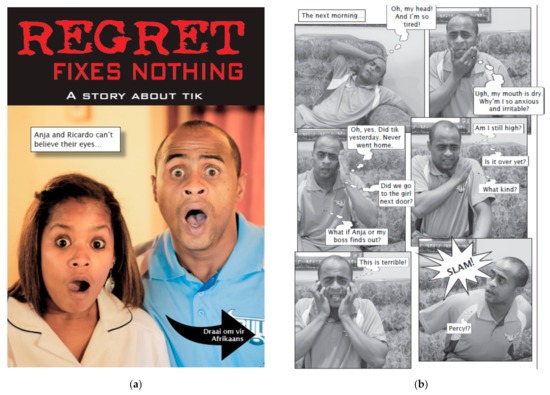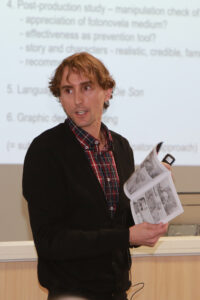
Cover page and an example page of the fotonovela version in English
How do we spread awareness about serious issues in communities – like the dangers of drugs like crystal meth – the importance of contraception and the consequences of diabetes? A Stellenbosch University lecturer was recently invited by the Keck School of Medicine at the University of Southern California in the US to talk about a new approach used in the Western Cape. Here, the use of photo novellas – a little book that tells a hard-hitting story with eye-catching graphics – has been shown to make a big impact.
Dr Burt Davis, Senior Lecturer at the Africa Centre for Inclusive Health Management (Africa Centre) at Stellenbosch University, gave a fascinating insight to a new way to engage communities about serious health challenges.
Moving away from pamphlets that are easily discarded and ignored, this approach entails photo novellas (or visual storybook), which use storytelling techniques to engage users. Everyday characters and situations are depicted to share important health messages. Dr Davis explained that while the novellas might look simple, there’s careful thought behind them.
Dr Davis was recently invited by the Keck School of Medicine at the University of Southern California in the US, to present his work as they conducted similar research about photo novellas – especially among Latino communities in the greater Los Angeles area.
The first story Dr Davis shared was how the use of crystal meth is illustrated in Cape Town, through a photo novella or storybook entitled: Regret Fixes Nothing. This ended with the main character’s arrest; an abrupt ending that drew on fear appeal theory to spark reflection. Others have leaned on cultural narratives, stigma theory and ideas from entertainment education, like identification and similarity, to make sure the messages resonate.

“What we found was that after reading the photo novella, readers with low health literacy levels had significantly higher knowledge scores,” said Dr Davis. Photo novellas are particularly powerful in South Africa, where high illiteracy rates make traditional pamphlets less effective. By using images, dialogue and stories told in local languages, they help people understand health information and see their relevance.
Community response has been overwhelmingly positive. People engage with the stories, talk about them and use them as springboards for conversations. The booklets bridge the gap between academic research and everyday experience, making abstract health concepts human and relatable.
In the seminar, Dr Davis shared how this tool, inspired by his childhood love of comics and photo stories, was even being considered for use in a proposed study on Human papillomavirus (HPV).
The process is deeply community-based. Local residents, often young people, are featured in the stories, bringing authenticity and relatability to each narrative. This approach creates opportunities for participants to grow, gain confidence, and feel part of something bigger. Professional producers and photographers step in to guide the process, ensuring the final product is well-executed without losing its grassroots spirit.
“We want to look at the underlying mechanisms; things in entertainment education like transportation, identification and similarity. That’s all based on theoretical models, so we can test it,” said Davis. Theoretical foundations ensure that the stories entertain, shift knowledge, attitudes, and behaviours.
As Davis emphasised, the success of photo novellas lies in their co-creation with communities, their grounding in theory and their ability to deliver health information through stories people see as their own.
So far, the photo novellas have been translated into three different languages. A total of 10 000 copies have been distributed among various NGOs, clinics and partners, while the local Department of Health in the Western Cape Province also distributed the booklets in their clinics.
Watch the full recording here.
